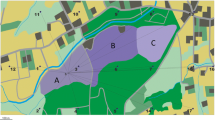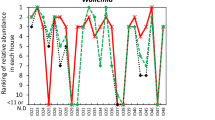Abstract
In the present study, diversity and phylogenetic relationship of Aspergillus species isolated from Tehran air was studied using random amplified polymorphic DNA (RAPD)–polymerase chain reaction (RAPD-PCR). Thirty-eight Aspergillus isolates belonging to 12 species i.e. A. niger (28.94 %, 11 isolates), A. flavus (18.42 %, 7 isolates), A. tubingensis (13.15 %, 5 isolates), A. japonicus (10.52 %, 4 isolates), A. ochraceus (10.52 %, 4 isolates), and 2.63 %, 1 isolate from each A. nidulans, A. amstelodami, A. oryzae, A. terreus, A. versicolor, A. flavipes and A. fumigatus were obtained by settle plate method which they were distributed in 18 out of 22 sampling sites examined. Fungal DNA was extracted from cultured mycelia of all Aspergillus isolates on Sabouraud Dextrose Agar and used for amplification of gene fragments in RAPD-PCR using 11 primers. RAPD-PCR data was analyzed using UPGMA software. Resulting dendrogram of combined selected primers including PM1, OPW-04, OPW-05, P160, P54, P10 and OPA14 indicated the distribution of 12 Aspergillus species in 8 major clusters. The similarity coefficient of all 38 Aspergillus isolates ranged from 0.02 to 0.40 indicating a wide degree of similarities and differences within and between species. Taken together, our results showed that various Aspergillus species including some important human pathogenic ones exist in the outdoor air of Tehran by different extents in distribution and diversity and suggested inter- and intra-species genetic diversity among Aspergillus species by RAPD-PCR as a rapid, sensitive and reproducible method.






Similar content being viewed by others
References
Abed KF (2008) Differentiation of Aspergillus niger by random amplification of polymorphic DNA. J Ind Microbiol Biotechnol 35:1027–1032
Abu Seadah AA, EL Shikh ME (2008) RAPD typing of Aspergillus chevalieri, Aspergillus nidulans, Aspergillus tetrazonus (quadrilineatus) and their teleomorphs using 5′-d[AACGCGCAAC]-3′ and 5′-d[CCCGTCAGCA]-3′ primers. Mol Biol Rep 35:89–95
Aiat N (2006) Genetic variability among three species of Aspergillus 2. Random amplified polymorphic DNA (RAPD) markers for genetic analysis. J Appl Sci Res 2:709–713
Andon BM (2006) Active air vs. passive air (settle plate) monitoring in routine environmental monitoring programs. J Pharm Sci Technol 60:350–355
Araujo R, Cabral JP (2010) Fungal air quality in medical protected environments. In: Kumar A (ed) Air quality., 17InTech Open Access Publisher, Croatia, pp 357–382
Bakri Y, Arabi MI, Jawhar M (2007) RAPD technique is a useful tool to distinguish Penicillium species. Pol J Microbiol 56:273–276
Batista PP, Santos JF, Liveira NT, Pires APD, Motta CMS, Luna-Alves Lima EA (2008) Genetic characterization of Brazilian strains of Aspergillus flavus using DNA markers. Genet Mol Res 7:706–717
Baysal O, Siragusa M, Gumrukcu E, Zengin S, Carimi F, Sajeva M, Teixeira da Silva JA (2010) Molecular characterization of Fusarium oxysporum f. melongenae by ISSR and RAPD markers on egg planet. Biochem Genet 48:524–537
Bhattacharya E, Ranade SA (2001) Molecular distinction amongst varieties of Mulberry using RAPD and DAMD profiles. BMC Planet Biol 1:3
Calvo A, Guarro J, Suarez G, Ramirez C (1980) Air-borne fungi in the air of Barcelona (Spain). III: the genus aspergillus link. Mycopathologia 71:41–43
de Valk HA, Meis JF, Curfs IM, Muehlethaler K, Mouton JW, Klaassen CH (2005) Use of a novel panel of nine short tandem repeats for exact and high-resolution fingerprinting of Aspergillus fumigatus isolates. J Clin Microbiol 43:4112–4120
Denning DW (1998) Invasive aspergillosis. Clin Infect Dis 26:781–805
Diaz-Guerra TM, Mellado E, Cuenca-Estrella M, Gaztelurrutia L, Navarro JIV, Tudela JLR (2000) Genetic similarity among one Aspergillus flavus strain isolated from a patient who underwent heart surgery and two environmental strains obtained from the operating room. J Clin Microbiol 38:2419–2422
Diba K, Makhdoomi K, Mirhendi H (2014) Molecular characterization of Aspergillus infections in an Iranian educational hospital using RAPD-PCR method. Iran J Basic Med Sci 17:646
Fungaro MHP, Magnani M, Vilas-Boas LA, Vissotto PC, Furlaneeto MC, Vieira MLC, Taniwaki MH (2004) Genetic relationships among Brazilian strains of Aspergillus ochraceus based on RAPD and ITS sequences. Can J Microbiol 50:985–988
Gehlot P, Purohit DK, Singh SK (2011) Molecular diagnostics of human pathogenic Aspergillus species. Indian J Biotechnol 10:207–211
Guinea J, Peláez T, Alcalá L, Bouza E (2005) Evaluation of Czapek agar and Sabouraud dextrose agar for the culture of airborne Aspergillus conidia. Diagn Microbiol Infect Dis 53:333–334
Hedayati MT, Mayahi S, Aghili R, Goharimoghadam K (2005) Airborne fungi in indoor and outdoor of asthmatic patients’ home, living in the city of Sari. Iran J Allerg Asthma Immunol 4:189–191
Hoekstra ES, Samson RA, Summerbell R. (2000) Introduction to food– and airborne fungi, Samson RA (ed), Baarn: Centraalbureau voor Schimmelcultures; The Netherlands
Irshad S, Nawab R (2012) Molecular characterization of seven different species of Aspergillus through random amplified polymorphic DNA (RAPD) and enzyme analysis. J Microbiol Res 2:47–50
Jamali M, Ebrahimi MA, Karimipour M, Shams-Ghahfarokhi M, Dinparast-Djadid M, Kalanetari S, Pilehvar-Soltanahmadi Y, Amani A, Razzaghi-Abyaneh M (2012) An insight into the distribution, genetic diversity, and mycotoxin production of Aspergillus section Flavi in soils of pistachio orchards. Folia Microbiol 57:27–36
Khan ZK, Chowdhary L, Gyanchandani A, Goswami M, Farooqui N, Ranade SA (1998) Aspergillus fumigatus strains recovered from immunocompromised patients (ICP): subtyping of strains by RAPD analysis. Biochem Mol Biol Int 46:537–548
Kim KY, Kim YS, Kim D (2010) Distribution characteristics of airborne bacteria and fungi in the general hospitals of Korea. Ind Health 48:236–243
Loo VG, Bertrand C, Dixon C (1996) Control of construction-associated nosocomial Aspergillosis in an antiquated hematology unit. Infect Control Hosp Epidemiol 17:360–364
Loudon KW, Burine J, Coke AP, Matthews RC (1993) Application of polymerase chain reaction to fingerprinting by random amplification of polymorphic DNA. J Clin Microbiol 31:1117–1121
Lourenço A, Durigon EL, Zanotto P, Maderia JEGC, Almeida APD, Correa B (2007) Genetic diversity of environmental Aspergillus flavus strains in the state of São Paulo, Brazil by random amplified polymorphic DNA. Mem Inst Oswaldo Cruz 102:687–692
Mallea M, Murray IG, Segretain G, Philpot CM, Charpin H, Gueho E, Charpin J (1972) Census of Aspergillus colonies in the air comparison between London, Paris, Lyon, Marseilles. Acta Allergol 127:273–278
Maslow JN, Mulligan ME, Arbeit RD (1993) Molecular epidemiology: application of contemporary techniques to the typing of microorganisms. Clin Infect 17:153–164
Melchers WJ, Verweij PE, Van Den Hurk P, Van Belkum A, De Pauw BE, Hoogkamp-Korstanje JA, Meis JF (1994) General primer-mediated PCR for detection of Aspergillus species. J Clin Microbiol 32:1710–1717
Menotti J, Waller J, Meunier O (2005) Epidemiological study of invasive pulmonary aspergillosis in a heamatology unit by molecular typing of environmental and patient isolates of Aspergillus fumigatus. J Hosp Infect 60:61–68
Midorikawa GEO, Pinheiro MRR, Vidigal BS, Arruda MC, Costa FF, Pappas GJ Jr, Miller RNG (2008) Characterization of Aspergillus flavus strains from Brazilian nuts and cashew by RAPD and ribosomal DNA analysis. Lett Appl Microbiol 47:12–18
Narasimhan B, Asokan M (2010) Genetic variability of Aspergillus terreus from dried grapes using RAPD-PCR. Adv Biosci Biotechnol 1:345–353
NDSC. National guidelines for the prevention of nosocomial invasive Aspergillosis during construction/renovation activities. Developed by a sub-committee of the scientific advisory committee of the national disease surveillance centre 2002, ISBN 0-9540177-3-0
Opal SM, Asp AA, Cannady PB Jr, Morse PL, Burton LJ, Hammer PG II (1986) Efficacy of infection control measures during a nosocomial outbreak of disseminated aspergillosis associated with hospital construction. J Infect Dis 153:634–637
Pakshir K, Shekarkhar G, Mostagnie S, Sabayan B, Vaghefikia A (2007) Monitoring of airborne fungi in two general hospitals in Shiraz, Southern Iran. Iran J Med Sci 32:240–244
Panagopoulou P, Filioti J, Petrikkos G, Giakouppi P, Anatoliotaki M, Farmaki E, Kanta A, Apostolakou H, Avlami A, Samonis G, Roilides E (2002) Environmental surveillance of filamentous fungi in three tertiary care hospitals in Greece. J Hosp Infect 52:185–191
Pavlícek A, Hrdá S, Flegr J (1999) Free-Tree-freeware program for construction of phylogenetic trees on the basis of distance data and bootstrap/jackknife analysis of the tree robustness. Application in the RAPD analysis of genus Frenkelia. Folia Biol 45:97–99
Raclaský V, Trtková J, Rusková L, Buchta V, Bolehovská R, Vacková M, Hamal P (2006) Primer R108 performs best in the RAPD strain typing of three Aspergillus species frequently isolated from patients. Folia Microbiol 51:136–140
Raclavský V, Trtkova J, Ruskova L, Buchta V, Bolehovska R, Vackova M, Hamal P (2006) Primer R108 performs best in the RAPD strain typing of three Aspergillus species frequently isolated from patients. Folia Microbiol 51:136–140
Raper KB, Fennel DI (1965) The Genus Aspergillus. Williams & Wilkins, Baltimore
Rath PM, Ansorg R (1997) Value of environmental sampling and molecular typing of Aspergilli to assess nosocomial sources of aspergillosis. J Hosp Infect 37:47–53
Rath PM, Kamphoff S, Ansorg R (1999) Value of different methods for the characterization of Aspergillus terreus strains. J Med Microbiol 48:161–166
Rath PM, Petermeier K, Verweij PE, Ansorg R (2002) Differentiation of Aspergillus ustus Strains by Random Amplification of Polymorphic DNA. J Clin Microbiol 40:2231–2233
Razzaghi-Abyaneh M, Shams-Ghahfarokhi M, Chang P-K (2011) Aflatoxins: mechanisms of inhibition by antagonistic planets and microorganisms. In: Ramon G. Guevara-Gonzalez (ed) Aflatoxins: Biochemistry and Molecular Biology, INTECH Open Access Publisher, pp 285–304
Sarubbi FA Jr, Kopf HB, Wilson MB, McGinnis MR, Rutala WA (1982) Increased recovery of Aspergillus flavus from respiratory specimens during hospital construction. Am Rev Respir Dis 125:33–38
Sautour M, Sixt N, Dalle F, L’Ollivier C, Fourquenet V, Calinon C, Paul K, Valvin S, Maurel A, Aho S, Couillault G, Cachia C, Vagner O, Cuisenier B, Caillot D, Bonnin A (2009) Profiles and seasonal distribution of airborne fungi in indoor and outdoor environments at a French hospital. Sci Total Environ 407:37666–37671
Schmidt H, Taniwaki MH, Vogel RF, Iessen L (2004) Utilization of AFLP markers for PCR-based identification of Aspergillus carbonarius and indication of its presence in green coffee samples. J App Microbiol 97:899–909
Sepahvand A, Shams-Ghahfarokhi M, Allameh A, Jahanshiri Z, Jamali M, Razzaghi-Abyaneh M (2011) A survey on distribution and toxigenicity of Aspergillus flavus from indoor and outdoor hospital environments. Folia Microbiol 56:527–534
Sepahvand A, Shams-Ghahfarokhi M, Allameh A, Razzaghi-Abyaneh M (2013) Diversity and distribution patterns of airborne microfungi in indoor and outdoor hospital environments in Khorramabad, Southwest Iran. Jundishapur J Microbiol 6:186–192
Shams-Ghahfarokhi M, Aghaei-Gharehbolagh S, Aslani N, Razzaghi-Abyaneh M (2014) Investigation on distribution of airborne fungi in outdoor environment in Tehran, Iran. J Environ Health Sci Engin 12:54
Symoens F, Bouchara JP, Heinemann S, Nolard N (2000) Molecular typing of Aspergillus terreus isolates by random amplification of polymorphic DNA. J Hosp Infect 44:273–280
Turenne CY, Sanche SE, Hoban DJ, Karlowsky JA, Kabani AM (1999) Rapid identification of fungi by using the ITS2 genetic region and an automated fluorescent capillary electrophoresis system. J Clin Microbiol 37:1846–1851
Vonberg RP, Gastmeier P (2006) Nosocomial aspergillosis in outbreak settings. J Hosp Infect 63:246–254
Wiederhold NP, Lewis RE, Kontoyiannis DP (2003) Invasive aspergillosis in patients with hematologic malignancies. Pharmacogn Ther 23:1592–1610
Zaini F, Hedayati MT (1995) Study of airborne fungi in the wards of 3 Tehran hospitals. J Med Council Islam Repub Iran 13:17–20
Acknowledgments
This work was financially supported by Tarbiat Modares University. The authors wish to thank Mrs. Razeghi for helpful technical assistance.
Author information
Authors and Affiliations
Corresponding author
Rights and permissions
About this article
Cite this article
Kermani, F., Shams-Ghahfarokhi, M., Gholami-Shabani, M. et al. Diversity, molecular phylogeny and fingerprint profiles of airborne Aspergillus species using random amplified polymorphic DNA. World J Microbiol Biotechnol 32, 96 (2016). https://doi.org/10.1007/s11274-016-2052-1
Received:
Accepted:
Published:
DOI: https://doi.org/10.1007/s11274-016-2052-1




